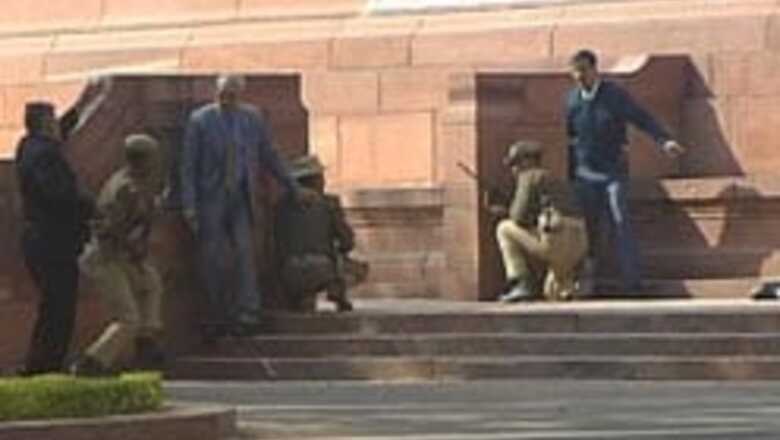
views
New Delhi: Exactly five years back from this day, terrorists stormed Parliament House in a suicidal attack killing eight and injuring 18.
As the country looks back again to the daring attack on the very symbol of democracy, writer-activist Arundhati Roy poses 13 questions for the Government of India and the investigating agencies to answer.
She contends close-circuit television (CCTV) cameras recorded the entire incident live. It showed six terrorists getting out of the car. Five years later, both the CCTV recordings and the details of the sixth terrorist remain hidden from the nation
Why was the CCTV recordings not produced in the court during the trial in the case? Why was it not released for public viewing? Who was the sixth person in the car involved in the attacks?
The worst attack on the very symbol of Indian democracy left eight people dead Five terrorists were gunned down on the site in a bloody, hour-long gun battle. Five years on, the anniversary of December 13 has prompted political parties and activists groups to take pole positions in order to raise a new pitch in support of their demands.
The death sentence awarded to Mohammad Afzal Guru – the main accused for the Parliament attacks – and the mercy plea that followed have added a new twist to the story in the run-up to the December 13 anniversary this year.
While the Opposition BJP has been heckling the government over the delay in taking a decision on the mercy plea of Mohammad Afzal Guru, activists and rights groups have released a book, titled 13 December – A Reader: The Strange Case of the Attack on the Indian Parliament.
The book, a collection of essays by prominent people – including writers, activists, media persons and lawyers – raises issues regarding the whole episode and questions what they call "fabricated evidence, procedural flaws and the outright lies" that were presented in the court and published in newspapers.
Roy has been in the forefront of the campaign against the death sentence to Mohammad Afzal Guru. Writing the introduction of the book, she has raised 13 questions about December 13.
Among other things, Roy has questioned the very motive behind the military mobilisation on the Pakistan border in the immediate aftermath of December 13 attacks; sought to know the identities of the five ‘terrorists’ killed in the Parliament attack; asked security agencies to identify the 'sixth terrorist' in the car involved in the attack and also wanted to know what were the ‘incontrovertible evidence’ of Pakistan’s involvement in the attack.
Other writers of the book include AG Noorani, Ashok Mitra, Indira Jaising, Jawed Naqvi, Mihir Srivastava, Nandita Haksar, Nirmalangshu Mukherji, Praful Bidwai, Shuddhabrata Sengupta, Sonia Jabbar, Syed Bismillah Geelani and Tripta Wahi. The book is scheduled to be released on Tuesday evening.
A group of citizens, led by veteran Gandhian Nirmala Deshpande, has been campaigning against the death sentence for Afzal. They have also moved President APJ Abdul Kalam, saying that many questions remain unanswered with regard to Afzal’s trial and demanded a parliamentary enquiry into the whole episode. There is also an online petition demanding the same.
Next Page: Roy's 13 Questions about December 13:
PAGE_BREAK
Arundhati Roy's 13 Questions about December 13:Question 1: For months before the Attack on Parliament, both the government and the police had been saying that Parliament could be attacked. On December 12, 2001, at an informal meeting the Prime Minister Atal Bihari Vajpayee warned of an imminent attack on Parliament. On December 13, Parliament was attacked. Given that there was an ‘improved security drill’, how did a car bomb packed with explosives enter the parliament complex?
Question 2: Within days of the Attack, the Special Cell of Delhi Police said it was a meticulously planned joint operation of Jaish-e-Mohammad and Lashkar-e-Toiba. They said the attack was led by a man called ‘Mohammad’ who was also involved in the hijacking of IC-814 in 1998. (This was later refuted by the CBI.) None of this was ever proved in the court. What evidence did the Special Cell have for its claim?
Question 3: The entire attack was recorded live on Close Circuit TV (CCTV). Congress Party MP Kapil Sibal demanded in Parliament that the CCTV recording be shown to the members. He was supported by the Deputy Chairman of the Rajya Sabha, Najma Heptullah, who said that there was confusion about the details of the event. The Chief Whip of the Congress Party, Priya Ranjan Dasmunshi, said: ‘I counted six men getting out of the car. But only five were killed. The close-circuit TV camera recording clearly showed the six men.’ If Dasmunshi was right, why did the police say that there were only five people in the car? Who was the sixth person? Where is he now? Why was the CCTV recording not produced by the prosecution as evidence in the trial? Why was it not released for public viewing?
Question 4: Why was Parliament adjourned after some of these questions were raised?
Question 5: A few days after December 13 attacks, the government declared that it had ‘incontrovertible evidence’ of Pakistan’s involvement in the attack, and announced a massive mobilisation of almost half-a-million soldiers to the Indo-Pakistan border. The subcontinent was pushed to the brink of nuclear war. Apart from Afzal’s ‘confession’, extracted under torture (and later set aside by the Supreme Court), what was the ‘incontrovertible evidence’?
Question 6: Is it true that the military mobilisation to the Pakistan border had begun long before the December 13 Attack?
Question 7: How much did this military standoff, which lasted for nearly a year, cost? How many soldiers died in the process? How many soldiers and civilians died because of mishandled landmines, and how many peasants lost their homes and land because trucks and tanks were rolling through their villages, and landmines were being planted in their fields?
Question 8: In a criminal investigation it is vital for the police to show how the evidence gathered at the scene of the attack led them to the accused. How did the police reach Mohammad Afzal? The Special Cell says SAR Geelani led them to Afzal. But the message to look out for Afzal was actually flashed to the Srinagar Police before Geelani was arrested. So how did the Special Cell connect Afzal to the 13 December Attack?
Question 9: The courts acknowledge that Afzal was a surrendered militant who was in regular contact with the security forces, particularly the Special Task Force (STF) of Jammu & Kashmir Police. How do the security forces explain the fact that a person under their surveillance was able to conspire in a major militant operation?
Question 10: Is it plausible that organizations like Lashkar-e-Toiba or Jaish-e-Mohammed would rely on a person who had been in and out of STF torture chambers, and was under constant police surveillance, as the principal link for a major operation?
Question 11: In his statement before the court, Afzal says that he was introduced to ‘Mohammed’ and instructed to take him to Delhi by a man called Tariq, who was working with the STF. Tariq was named in the police charge sheet. Who is Tariq and where is he now?
Question 12: On 19 December 2001, six days after the Parliament Attack, Police Commissioner, Thane (Maharashtra), S.M. Shangari identified one of the attackers killed in the Parliament Attack as Mohammad Yasin Fateh Mohammed (alias Abu Hamza) of the Lashkar-e-Toiba, who had been arrested in Mumbai in November 2000, and immediately handed over to the J&K Police. He gave detailed descriptions to support his statement. If Police Commissioner Shangari was right, how did Mohammad Yasin, a man in the custody of the J&K Police, end up participating in the Parliament Attack? If he was wrong, where is Mohammad Yasin now?
Question 13: Why is it that we still don’t know who the five dead ‘terrorists’ killed in the Parliament Attack are?















Comments
0 comment